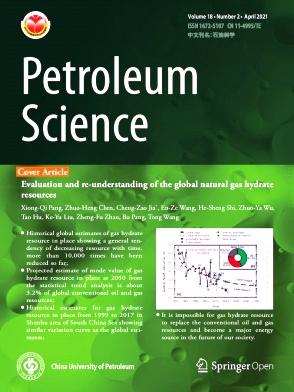Experimental investigation into CO2 huff-n-puff in low-permeability heavy oil reservoirs: Role of fractures
IF 6
1区 工程技术
Q2 ENERGY & FUELS
引用次数: 0
Abstract
Low-permeability heavy oil reservoirs are characterized by poor flowability, generally mandating hydraulic fracturing to commence production. CO2 huff-n-puff in fractured reservoirs is an effective enhanced oil recovery method. This paper uses nuclear magnetic resonance imaging to elucidate the role of propped and unpropped fractures on CO2 huff-n-puff in cores under different confining pressures. In presence of fractures, significant improvement in the rate of early stage oil recovery is observed, up to 0.255 mL/min. Fractures enlarge the contact area between CO2 and the heavy oil, hence improve CO2 dissolution and oil flowability. Fractures improve oil recovery from micropores, small pores, and mesopores, as well as reduce CO2 consumption ratio. The oil recovery factor in propped fractures is significantly higher than that in unpropped fractures, and with higher oil recovery from small pores and mesopores. The oil recovery in fractured cores noticeably decreases with increasing confining pressure. The extent of fracture closure increases and the matrix pore throats compress under pressure leading to lower apparent permeability. The decrease in oil recovery factor is more pronounced in unpropped fractured cores. A relationship between the apparent permeability of the fracture aperture is derived based on the modified cubic law of percolation to quantitatively characterize the fracture. Additionally, both the reduction in heavy oil viscosity and the increase in experimental temperature and pressure can improve the CO2 huff-n-puff oil recovery factor in fractured cores.
求助全文
约1分钟内获得全文
求助全文
来源期刊

Petroleum Science
地学-地球化学与地球物理
CiteScore
7.70
自引率
16.10%
发文量
311
审稿时长
63 days
期刊介绍:
Petroleum Science is the only English journal in China on petroleum science and technology that is intended for professionals engaged in petroleum science research and technical applications all over the world, as well as the managerial personnel of oil companies. It covers petroleum geology, petroleum geophysics, petroleum engineering, petrochemistry & chemical engineering, petroleum mechanics, and economic management. It aims to introduce the latest results in oil industry research in China, promote cooperation in petroleum science research between China and the rest of the world, and build a bridge for scientific communication between China and the world.
 求助内容:
求助内容: 应助结果提醒方式:
应助结果提醒方式:


